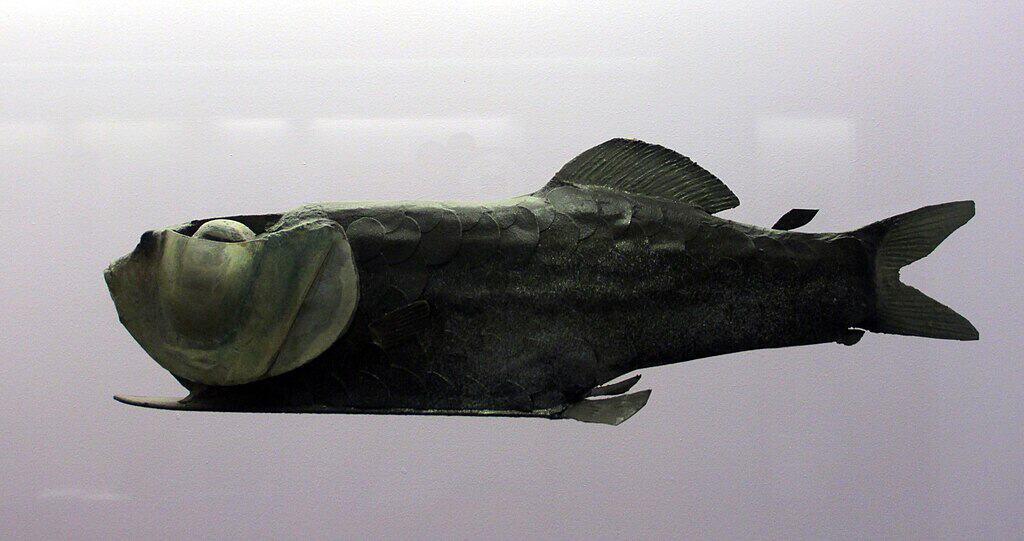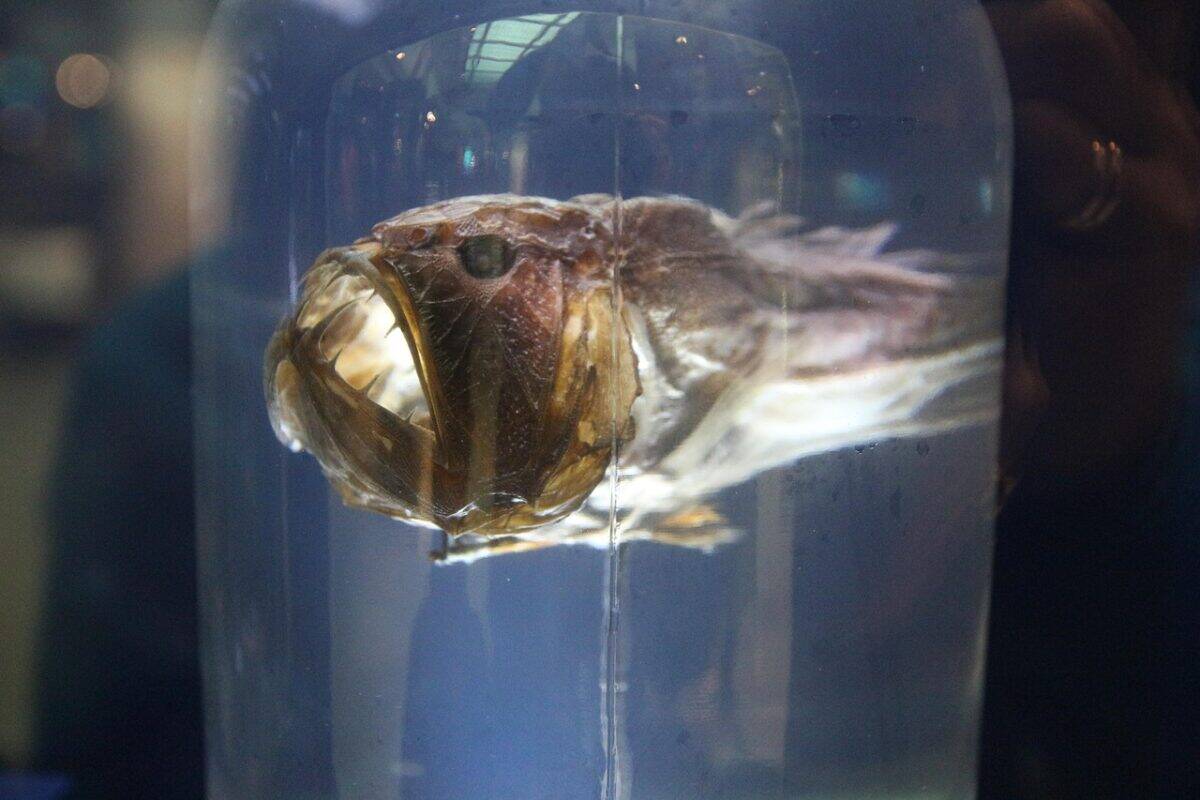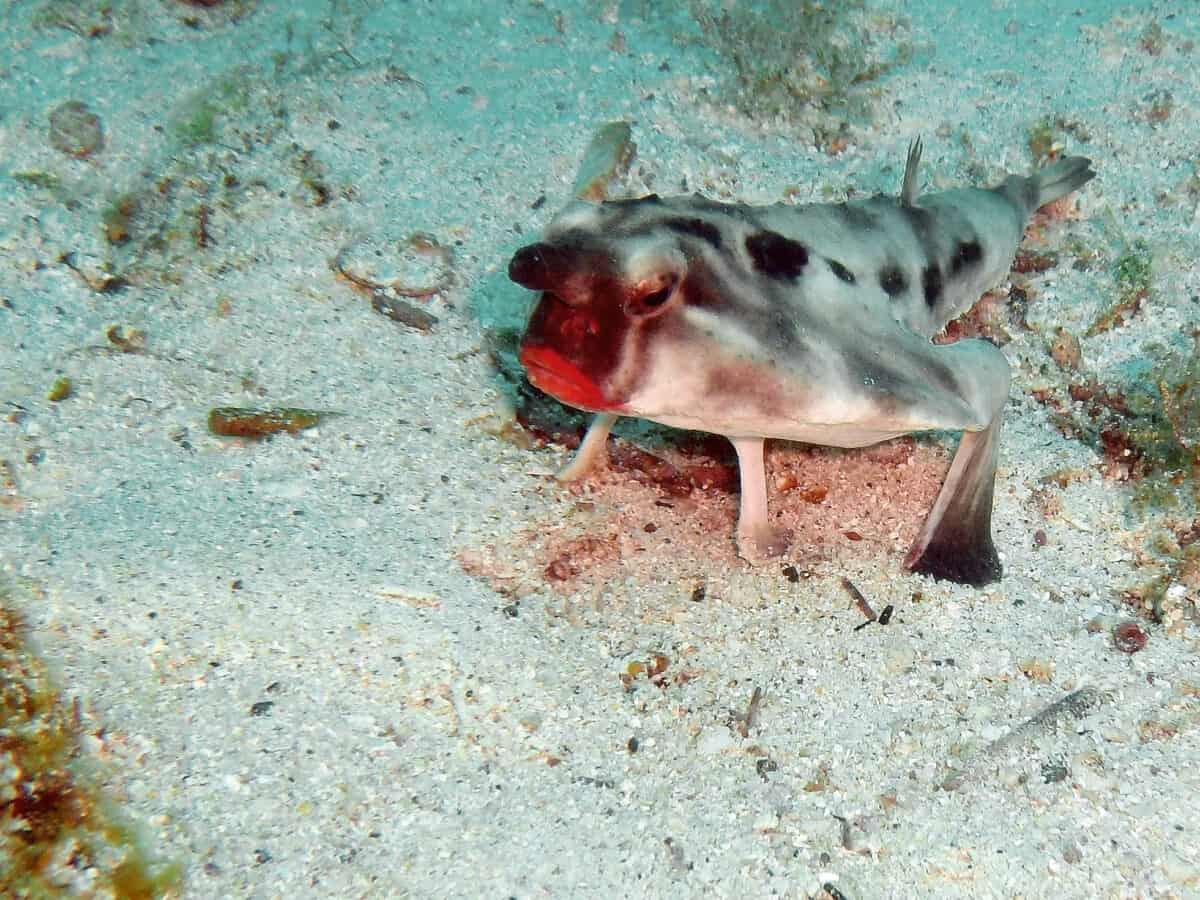The oceans and freshwater systems of our planet house some of the most bizarre and fascinating creatures on Earth. Fish, having evolved over 500 million years, have adapted to virtually every aquatic environment imaginable—from the crushing depths of ocean trenches to the murky waters of swamps. This evolutionary journey has produced some truly outlandish designs that challenge our very notion of what a fish should look like. In this exploration of aquatic oddities, we’ll dive deep into the world of the strangest, most peculiar fish ever discovered by science. These remarkable creatures demonstrate nature’s endless creativity and the extreme adaptations that help species survive in their unique ecological niches.
14. Blobfish (Psychrolutes marcidus)

Perhaps the most famous “ugly” fish, the blobfish became an internet sensation after being named the world’s ugliest animal in 2013. However, this gelatinous-looking creature appears quite different in its natural habitat. Native to the deep waters off the coasts of Australia and New Zealand at depths between 600-1,200 meters, the blobfish has evolved to survive in an environment with crushing pressure—up to 120 times greater than at sea level. Its body consists primarily of a gelatinous mass with a density slightly less than water, allowing it to float just above the seafloor with minimal energy expenditure. What we typically see in photographs is actually a decompressed specimen; when removed from deep water, the dramatic change in pressure distorts its body into the familiar “blob” appearance. In its natural habitat, the blobfish looks much more like a conventional fish, though still with a distinctive droopy appearance.
13. Barreleye Fish (Macropinna microstoma)

The barreleye fish, sometimes called the “spook fish,” possesses one of the most alien-like features in the animal kingdom: a transparent head filled with fluid. Through this clear dome, you can see its tubular, bright green eyes that point upward, searching for the silhouettes of potential prey above. What makes this fish truly remarkable is that these eyes can rotate within the transparent shield, allowing the barreleye to look forward when needed. Discovered in the early 1900s but rarely observed alive until 2004, this deep-sea dweller lives at depths of 600-800 meters in the Pacific Ocean. The barreleye’s body is small (typically 15 cm long) and dark, helping it remain hidden from predators below, while its extraordinary vision system allows it to spot the faint bioluminescence of jellies and other prey. Scientists believe the transparent head serves as protection for its sensitive eyes while also enhancing its upward vision.
12. Anglerfish (Family Lophiiformes)

Few fish inspire as much fascination and horror as the deep-sea anglerfish. With their enormous heads dominated by cavernous mouths filled with needle-like teeth, these hunters of the abyss embody the nightmarish creativity of evolution. Their most famous feature is the bioluminescent lure—technically a modified dorsal spine—that dangles from their foreheads. This fishing rod-like appendage contains symbiotic bacteria that produce light, attracting curious prey close to the anglerfish’s waiting jaws. What’s equally bizarre is their reproductive strategy: male anglerfish are tiny compared to females, and in many species, the male permanently fuses to the female’s body, essentially becoming a parasitic sperm bank. The male’s body atrophies until little remains except reproductive organs, ensuring the female has a constant supply of sperm. With over 200 species inhabiting the deep oceans worldwide, anglerfish range in size from a few centimeters to over a meter, each with its own unique adaptations to life in the darkness.
11. Goblin Shark (Mitsukurina owstoni)

Often called a “living fossil,” the goblin shark represents a lineage that has remained relatively unchanged for about 125 million years. The most immediately striking feature of this deep-sea predator is its protrusible jaws that can be thrust forward to snatch prey in a lightning-fast motion—an adaptation that looks straight out of science fiction. The elongated, flattened snout (called a rostrum) contains specialized sensory organs that detect the electrical fields produced by other animals, allowing the goblin shark to hunt effectively in the pitch-black waters it inhabits. With its pale pink coloration resulting from blood vessels visible through translucent skin, small eyes, and nail-like teeth, this shark has an undeniably eerie appearance. Rarely encountered by humans, goblin sharks typically live at depths of 270-960 meters and can grow up to 6 meters long, though most specimens are smaller. Despite their fearsome appearance, they pose no threat to humans due to their deep-water habitat and relatively sluggish nature.
10. Red-lipped Batfish (Ogcocephalus darwini)

If any fish appears to be the result of an evolutionary practical joke, it’s the red-lipped batfish. Found primarily around the Galápagos Islands at depths of 3-76 meters, this peculiar creature sports what appears to be bright red lipstick, giving it an almost comical, made-up appearance. What makes this fish even more unusual is that it’s terrible at swimming. Instead, the red-lipped batfish has evolved modified pectoral fins that function like legs, allowing it to “walk” across the ocean floor in search of small crustaceans, mollusks, and worms. A spine-like protrusion on its head called an illicium acts as a lure to attract prey, similar to anglerfish but without the bioluminescence. Scientists believe the distinctive red lips may play a role in species recognition and attracting mates, though the exact purpose remains a subject of ongoing research. Typically growing to about 20 centimeters in length, these fish represent an extraordinary example of adaptation to a specific ecological niche.
9. Frilled Shark (Chlamydoselachus anguineus)

Sometimes referred to as a “living fossil,” the frilled shark has changed little in appearance for approximately 80 million years. With its elongated, eel-like body and primitive features, this deep-sea predator looks like it swam straight out of prehistoric times. The frilled shark gets its name from its six pairs of gill slits that create a frilled appearance around its neck region. Its mouth, positioned at the end of its snout rather than underneath like most modern sharks, contains about 300 trident-shaped teeth arranged in 25 rows—specialized for capturing slippery prey like squid and fish. Growing up to 2 meters in length, frilled sharks typically inhabit depths between 50-1,500 meters, though they’re occasionally spotted in shallower waters. Their flexible jaws and expandable stomach allow them to swallow prey whole, sometimes consuming creatures nearly half their size. Rarely seen alive by humans due to their deep-water habitats, frilled sharks were only discovered in the 19th century and remain a source of fascination for marine biologists studying the evolutionary history of cartilaginous fishes.
8. Stargazer Fish (Family Uranoscopidae)

With eyes and mouth positioned on top of a flat head, the stargazer fish has earned its name by perpetually staring upward while buried in the sand, waiting for unsuspecting prey to swim overhead. These ambush predators possess several unusual adaptations that make them among the most bizarre fish in the ocean. Some species have specialized organs behind their eyes capable of delivering electric shocks of up to 50 volts—making them among the few fish that can generate electricity. Many also have a worm-shaped lure that extends from their mouth to entice prey within striking distance. Perhaps most disturbing are the teeth lining their mouths and even their lips, creating a gnashing trap that’s difficult for captured prey to escape. Found in both temperate and tropical seas worldwide, stargazers range in size from 18 to 90 centimeters, depending on the species. Despite their alien appearance, these fish are sometimes sold in markets and considered a delicacy in some Mediterranean and Asian cuisines, though the organs capable of delivering electric shocks must be carefully removed before preparation.
7. Hoodwinker Sunfish (Mola tecta)

The hoodwinker sunfish managed to “hoodwink” scientists until 2017, when it was finally recognized as a distinct species separate from other ocean sunfishes. Like its relatives, the hoodwinker has an extremely unusual body plan—essentially a giant head with a rudimentary tail, creating a flattened, disc-like appearance. What distinguishes this species is its slimmer profile and characteristic scale structure that forms a band-like pattern not found in other Mola species. Growing up to 2.5 meters in length and potentially weighing over a ton, these giants feed primarily on jellyfish and salps. Unlike other sunfish that often bask at the water’s surface (hence the name “sunfish”), the hoodwinker appears to spend more time in deeper waters, which helped it remain undiscovered for so long despite its enormous size. Originally thought to be confined to the waters around Australia, New Zealand, and South Africa, surprising discoveries of specimens in California and Oregon have revealed that this fish has a much wider distribution than initially believed, highlighting how much remains unknown about even the largest creatures in our oceans.
6. Leafy Seadragon (Phycodurus eques)

The leafy seadragon represents nature’s mastery of camouflage, with body projections that so perfectly mimic floating seaweed that these fish can be nearly impossible to spot in their natural habitat. Related to seahorses and pipefish, these Australian endemics grow to about 35 centimeters long and are adorned with elaborate leaf-like appendages in yellows, browns, and greens that match the kelp and seagrass meadows they inhabit. Unlike their seahorse cousins, leafy seadragons don’t have a prehensile tail to anchor themselves; instead, they drift with the current, resembling floating vegetation. They possess a long, tube-like snout for precise feeding on tiny crustaceans, mysid shrimp, and other small organisms. Like seahorses, male leafy seadragons are responsible for carrying fertilized eggs—though they lack a pouch and instead incubate up to 250 bright pink eggs on a specialized patch under their tails for 4-6 weeks until hatching. Protected by Australian law since 1982, these extraordinary creatures face threats from habitat destruction, pollution, and illegal collection for aquariums, making conservation efforts crucial to their survival.
5. Gulper Eel (Eurypharynx pelecanoides)

Also known as the pelican eel, the gulper eel possesses one of the most extreme mouth-to-body ratios in the animal kingdom. This deep-sea dweller’s massive jaw can unhinge and expand to swallow prey much larger than itself—a remarkable adaptation to an environment where meals are few and far between. The eel’s body is extraordinarily thin and black, contrasting dramatically with its enormous mouth. Growing up to 1.8 meters long, much of this length consists of an extremely thin, whip-like tail tipped with a light-producing organ that may function as a lure. Unlike many deep-sea creatures that have reduced or lost their eyes, gulper eels possess relatively large eyes that may help them detect the faint bioluminescence of potential prey or mates in the darkness of depths between 500-3,000 meters. Despite their fearsome appearance, gulper eels feed primarily on small crustaceans and other invertebrates rather than large fish as their enormous mouths might suggest. Due to their extreme deep-sea habitat, much about their behavior and reproductive strategies remains unknown to science.
4. Tasselled Wobbegong (Eucrossorhinus dasypogon)

The tasselled wobbegong combines extraordinary camouflage with an unmistakably peculiar appearance. This carpet shark, found in the shallow coral reefs of northern Australia, Indonesia, and Papua New Guinea, features an ornate array of branching dermal lobes around its mouth that perfectly mimic the coral and algae of its surroundings. Its flattened body, reaching up to 1.8 meters in length, is covered in an intricate pattern of spots, blotches, and saddles that break up its outline on the reef floor. The shark’s name comes from an Australian Aboriginal word meaning “shaggy beard,” referencing its distinctive facial appendages. Unlike most sharks that must swim continuously to breathe, wobbegongs are ambush predators that can remain motionless for hours, pumping water across their gills while lying in wait. When prey ventures too close, the wobbegong can strike with astonishing speed, expanding its jaw to engulf fish, crustaceans, and even other small sharks. Their excellent camouflage makes them potentially dangerous to divers who might accidentally step on or handle them, as they can deliver a powerful bite when provoked.
3. Vampire Squid (Vampyroteuthis infernalis)

Despite its name, the vampire squid is neither a squid nor an octopus but belongs to its own separate order, representing a phylogenetic relic that diverged from other cephalopods about 200 million years ago. Its scientific name translates to “vampire squid from hell,” yet this deep-sea inhabitant is far from the monster its name suggests. Living at depths of 600-900 meters in oxygen-minimum zones where few predators venture, the vampire squid has evolved remarkable adaptations to this extreme environment. Its most distinctive features include large eyes (proportionally the largest of any animal), a dark red to black coloration, and a web of skin connecting its eight arms, which it can invert over its head like a cloak when threatened—the cape-like appearance that inspired its vampire moniker. Unlike true squids, it lacks feeding tentacles and ink sacs. Instead, it deploys bioluminescent mucus when threatened and feeds primarily on marine snow (organic detritus) using two retractile filaments. Growing to only about 30 centimeters in length, vampire squids are relatively small but represent one of the most ancient and unusual cephalopod lineages still living today.
2. Megamouth Shark (Megachasma pelagios)

The megamouth shark remained completely unknown to science until 1976, making it one of the most recent discoveries of a large marine vertebrate. As its name suggests, this shark possesses an extraordinarily large mouth filled with about 50 rows of tiny teeth—an adaptation for its filter-feeding lifestyle. Growing up to 5.5 meters in length, the megamouth has a bulbous, rounded head with a short snout and a broadly rounded, almost circular mouth when open. Unlike most sharks, it has a soft, flabby body and a significantly reduced skeleton, contributing to its sluggish swimming style. The megamouth employs a unique feeding strategy: its rubbery lips are lined with light-producing photophores that scientists believe attract plankton and small fish, which it then engulfs while swimming with its mouth open. It’s known to engage in vertical migration, following its planktonic prey from depths of up to 1,000 meters during the day to about 15 meters at night. With fewer than 100 specimens ever documented, the megamouth remains one of the most elusive large marine animals, highlighting how much of the ocean’s biodiversity still awaits discovery.
1. Threadfin Dragonfish (Echiostoma barbatum)

The threadfin dragonfish embodies the alien aesthetic of deep-sea fauna with its jet-black body, enormous fang-like teeth, and specialized light-producing organs. Living at depths between 200-2,000 meters, this predator grows to about 35 centimeters and possesses a distinctive barbel (a whisker-like sensory appendage) protruding from its chin. What makes this barbel extraordinary is that it terminates in a complex, bioluminescent lure used to attract prey in the perpetual darkness. Unlike many bioluminescent fish that produce blue light, the threadfin dragonfish’s barbel emits red light—a wavelength that most deep-sea creatures cannot see, essentially giving this predator a “invisible spotlight” to hunt with. Along its body, rows of photophores (light-producing organs) create patterns.
Conclusion

From translucent heads and glowing lures to mouths that unhinge and bodies that mimic seaweed, the fish featured on this list showcase the astounding diversity and adaptability of life beneath the waves. These creatures are more than just curiosities—they’re examples of how evolution responds to extreme environments with remarkable solutions. Whether surviving in crushing ocean depths, camouflaging in coral reefs, or dazzling prey with bioluminescence, these weird-looking fish remind us how little we truly know about our planet’s oceans. As exploration and research continue to unveil new species and behaviors, one thing is certain: the underwater world is far stranger—and more wondrous—than we ever imagined.
- 15 Amazing Feats of Memory in the Animal Kingdom - August 14, 2025
- The Strange Truth Behind America Sudden Rise in Shark Attacks - August 14, 2025
- 12 US States Where Wolves Are Making a Comeback - August 13, 2025

